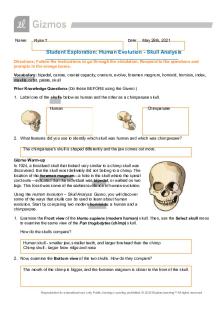Human vs Non Human ANT 265 PDF

| Title | Human vs Non Human ANT 265 |
|---|---|
| Course | Introduction to Forensic Anthropology |
| Institution | Washtenaw Community College |
| Pages | 3 |
| File Size | 129.2 KB |
| File Type | |
| Total Downloads | 72 |
| Total Views | 157 |
Summary
Human Vs Non Human: Lecture Notes, Definitions, Examples...
Description
Human vs Non-Human Bone + MNI Forensic Anthropology 265 3 Questions: 1. Is it really bone? 2. Is it human or non-human? 3. How many? (MNI) Is it bone? ● Many materials, including roots, wood fragments, shell, rocks and man-made objects (like styrofoam and plastic) are often confused with bone ● Generally, the more weathered and dirty, the more it looks like bone Bone is.. ● Surface: compact, some graininess ● Color/ Luster: Creamy white to yellowish brown with a dull luster ● Internal Structure: porous, spongy Other materials… ● Rock: Color is gray, tan or brown. Internally not porous/ spongy ● Shell: Smooth, weathers to white -> gray. Pearly luster ● Wood: Non-compact. Fibrous ● Pottery: Compact, smooth. Not spongy ● Plastic/ Styrofoam: non-compact, non-porous, non-spongy *It is okay to bend evidence upon discovery due to diagnostic process
Is it human? Strategy for Differenentiating Human and Non-human: “I don’t know where every sand barge on the river is, but I know where they ain’t” - Unknown Riverboat Captain *Encourages to learn the human skull as well as possible Distinguishing Aspects: ● Maturity: Adult animal bones have fused epiphysis; immature human bones do not ● Architecture / Function: Human bones have different functions than other mammals; leads to different shapes of the same bone
Functional Areas: ● Three areas are useful for differentiating human from non-human elements: ○ Skull ○ Dentition (diet) ○ Long Bones (locomotion) General Guidelines: ● Human bone is relatively lightweight compared to other mammals, but denser than birds, amphibians or reptiles ● Human upper limbs are not involved in locomotion; in most other animals they are. ● Human teeth are relatively small for our body size Cortical Thickness….
*See Professor Barretts notes for diagram of Cortical Thickness
Resources.. ● A book on comparative mammalian morphology, such as Skulls and Bones; a guide to the skeletal structures of North american mammals. By glenn seafros (1995 stackpole books: mechanicsburg, pa. ● Access to a comparative collection ● The aid of a trained zooarchaeologist
Bones of Confusion ● Clavicle: Cat clavicles look similar to human clavicles only smaller ● Black Bear phalanges look like human phalanges, but with a raised ridge on the distal aspect ○
●
** Look for ridge in bear phalanges
Humans do not have a bacula (penile bone) ○
** Look for juvenile rib bones (in humans)
Other Methods: ● Histology: Use of osteon counting or blood-typing to eliminate specimen as human ● DNA (expensive)
How Many? M.N.I ● Minimum Number of Individuals: Minimum number of individuals necessary to account for all elements in the assemblage Never assume that remains are from just one person ● If you identify bones are human.. Than minimum number is 1. (Example: If you have 100 bones… then, theoretically, you could have 100 different people) ● I.e. feature 7 of Lakeview Heights Farm **Don’t assume on death scene that you are studying only 1 victim Steps to Determine MNI 1. Remove all non-human elements 2. Group Elements (bone types: humerii, femurs, etc..) 3. Side elements 4. For each side / elements, count number 5. Whichever side / element is the highest = your MNI *In final report, demonstrate how this is only one person (or how it is multiple people) estimate of MNI (doesn’t have to be super complicated, just replicate the steps above!)...
Similar Free PDFs

Human vs Non Human ANT 265
- 3 Pages

ANT 150 Video Becoming Human
- 2 Pages

Human Rights
- 167 Pages

Human Geographers
- 2 Pages

Human Trafficking
- 3 Pages

Human Genetics
- 500 Pages

Human Flourishing
- 4 Pages

Human Evolution Gizmo - Ryan
- 8 Pages

human resource management
- 3 Pages

Human phys 2601 - Ionoregulation
- 2 Pages
Popular Institutions
- Tinajero National High School - Annex
- Politeknik Caltex Riau
- Yokohama City University
- SGT University
- University of Al-Qadisiyah
- Divine Word College of Vigan
- Techniek College Rotterdam
- Universidade de Santiago
- Universiti Teknologi MARA Cawangan Johor Kampus Pasir Gudang
- Poltekkes Kemenkes Yogyakarta
- Baguio City National High School
- Colegio san marcos
- preparatoria uno
- Centro de Bachillerato Tecnológico Industrial y de Servicios No. 107
- Dalian Maritime University
- Quang Trung Secondary School
- Colegio Tecnológico en Informática
- Corporación Regional de Educación Superior
- Grupo CEDVA
- Dar Al Uloom University
- Centro de Estudios Preuniversitarios de la Universidad Nacional de Ingeniería
- 上智大学
- Aakash International School, Nuna Majara
- San Felipe Neri Catholic School
- Kang Chiao International School - New Taipei City
- Misamis Occidental National High School
- Institución Educativa Escuela Normal Juan Ladrilleros
- Kolehiyo ng Pantukan
- Batanes State College
- Instituto Continental
- Sekolah Menengah Kejuruan Kesehatan Kaltara (Tarakan)
- Colegio de La Inmaculada Concepcion - Cebu





